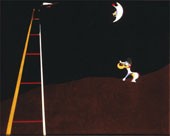Grade Level: 6-7
Students will identify polygons and angles in Tony Smith’s sculpture Moondog. They will then create a sculpture with polyhedra nets, calculate the cost of covering sculpture in gold, and write an exhibit label for their finished sculpture. Lastly, they will research the origin of words related to geometry.

Tony Smith
American, 1912–1980
Moondog, model 1964, fabricated 1998–1999
painted aluminum, 521.3 x 468 x 467.4 cm (205 1/4 x 184 1/4 x 184 in.), gross weight: 4,200 lbs
National Gallery of Art, Gift of The Morris and Gwendolyn Cafritz Foundation
Curriculum Connections
Materials
Warm-Up Questions
What would you name this work of art? Why?

Hans Namuth
Tony Smith, Early 1970s
silver gelatin photograph
©Hans Namuth Ltd.
Background
Tony Smith mixed art and math; for him, it was the most natural thing in the world. Suffering from tuberculosis as a child, he spent hours by himself, making buildings and miniature cities from small medicine boxes. He put the boxes—cubes and other polyhedra—together in different ways for his creations. He later said, "The most important fact of my life was that I had TB at a very early age."
Smith became an architect and painter and even worked for Frank Lloyd Wright in the late 1930s. When a serious car accident laid him up, he returned to his childhood pastime of making sculpture from boxes. Focusing on the tetrahedron and the cube, he developed his geometric vocabulary in monumental sculptures that were first fabricated from plywood and covered with black automobile undercoating. While many works were produced in steel and placed outdoors in urban plazas, many Tony Smith-sculptures remained in their maquette or inexpensive plywood forms.

Different vantage points of Smith’s Moondog
Art critics have often included Tony Smith in a group of sculptors known as Minimalists, artists of the 1960s who used simple geometric forms and industrial materials to create large-scale works. Minimalist sculpture is often characterized as austere and unemotional. While Smith used geometric solids in his sculpture, Smith's work isn't stiff or static. In fact, when viewing Moondog from several angles, you can tell it doesn't stand perfectly upright, as you might expect when looking at it head-on. It actually leans, tilts, and twists. Scholars say this gives it both a human aspect and a spiritual side. This sense of movement differentiates his sculpture from the straight lines and grids of most Minimalist work. Smith wanted his work to be "a conduit for spiritual things." He wrote: "All of my sculpture is on the edge of dreams."

Joan Miró
Dog Barking at the Moon, 1926
oil on canvas, 73 x 92.1 cm (28 3/4 x 36 1/4 in.)
Philadelphia Museum of Art, A. E. Gallatin Collection, 1952
His sculpture can be hard to understand because he tried to mix anthropomorphism (human scale and characteristics) with geometric sculpture—this was his way of reaching from earth into the universe for spiritual meaning. Smith said this sculpture reminded him of a Japanese lantern and of the human pelvis, the bones that hold our spine and legs together. But he named it Moondog for two reasons: after a blind poet and musician called "Moondog" who hung out on the streets of New York where Smith lived, and after a painting by Spanish artist Joan Miró of a dog barking at the moon.
Guided Practice
Activity
Students will design a Tony Smith-style sculpture to be placed in a garden using the “Build It and Gild It!” worksheet. They will construct a model, calculate its surface area, and even figure the cost of gold leaf needed to cover their sculpture!
Extension
What does the word root poly mean? What about tetra? Distribute the “T-Angling with Words” worksheet and ask students to match geometry word roots with their meanings.
VA:Cn11.1.7 Analyze how response to art is influenced by understanding the time and place in which it was created, the available resources, and cultural uses.
VA:Cr2.3.7 Apply visual organizational strategies to design and produce a work of art, design, or media that clearly communicates information or ideas.
VA:Pr5.1.6 Individually or collaboratively, develop a visual plan for displaying works of art, analyzing exhibit space, the needs of the viewer, and the layout of the exhibit.
VA:Re8.1.7 Interpret art by analyzing art-making approaches, the characteristics of form and structure, relevant contextual information, subject matter, and use of media to identify ideas and mood conveyed.